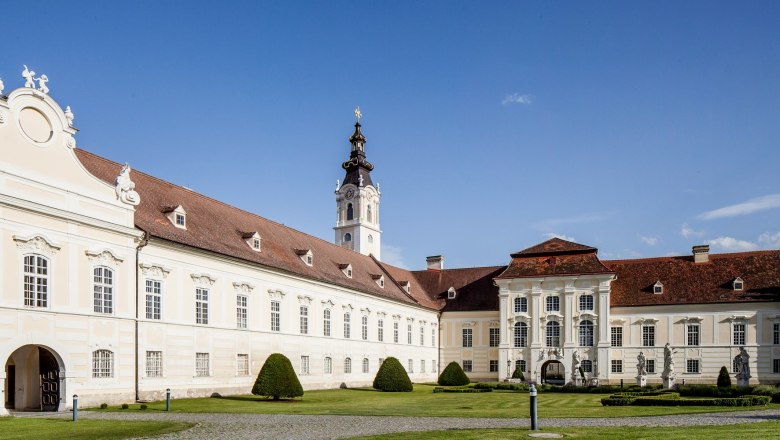Altenburg Abbey
A visit to the “Troger Monastery” – the Baroque gem of the Waldviertel.
Rising above the forests of the Kamp Valley, the Benedictine Abbey of Altenburg combines complete harmony with the essence of Baroque. The monastery is fascinating every step of the way, even in its deepest reaches. One name that is omnipresent here is Paul Troger. You come to fully appreciate his greatness in several respects at this site – and everyone should visit it at least once.
Cultural treasures thousands of years old
In 1144, Countess Hildburg bequeathed the Benedictine Abbey of Altenburg to the Bishop of Passau. Christian Benedictine life in the region then began with twelve monks from St. Lambrecht Abbey in Styria – at the site of an old fortress of the Lords of Poigreich, as Horn County was known at the time. Destruction and re-construction shaped the history of the abbey. After the Reformation and the Thirty Years’ War, the monks set about rebuilding the monastic complex in the 17th and 18th centuries. Under Abbot Benedikt Leiss (1648-1658), the old monastery was abandoned in order to build a new, larger complex in the style of the times. Abbot Maurus Boxler and Abbot Placidus Much left us the splendid monastery we know today. In 1940, the monastery was dissolved and its possessions were seized. From 1945 onward, it served as housing for 2,000 troops from the Russian occupying forces. Under Abbot Maurus Knappek (1947-1968), the ruin was converted back into a monastery and opened to the general public. In 2018, the abbey was awarded the national prize for exemplary forestry management and the prize in the special category for climate-compatible forests. It is a heavenly place with gardens you cannot help falling in love with.
The abbey under the abbey
For centuries, the remnants of the medieval monastery remained hidden under its splendid Baroque successor. This nearly forgotten witness to monastic life has now been uncovered again. Chapter house, cloister and scriptorium – on a tour, you set off on a fascinating trip back in time to centuries long past. It is a unique opportunity to explore and directly compare two different monasteries. Goosebumps included!
Frescoes from a master’s hand
The art-loving abbot Placidus Much brought together in Altenburg the best craftsmen and the most talented artists of his time to make his dream of universality a reality. The abbey church, the imperial staircase and the library bear a well-know signature, that of Paul Troger! The South Tyrolean painter executed ten dome frescoes for the abbey. In 1731 and 1733, he painted frescoes in the vault severies above the organ loft and the choir as well as the main dome, which covers an area of more than 700 m² – undoubtedly his most impressive work in Altenburg. All you can do in “Troger Abbey” is be amazed, time and time again! Viewed from the right vantage point, Troger’s works come alive.
An artwork in its totality
The Creation Garden, the Pharmacy Garden and the Cloister Garden awaken all five senses, as do the Garden of Silence and the Garden of Religions! The same is true of the concerts at the chamber music festival or performances of the Altenburg Boys’ Choir. Grand art meets connoisseurs here – now at the abbey restaurant as well. Please, take a seat in the Imperial Courtyard!
